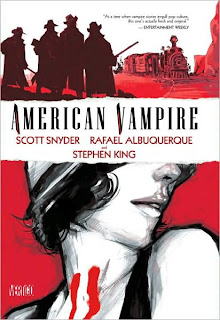 Today's book is a request, I guess, or a recommendation -- a fellow Wileyite e-mailed me to suggest it, and ten minutes later my library was holding it for me. (Well, perhaps it wasn't that quickly, but I had the hold in within half an hour and the book in my hands the next night.) And that small fact saves me from thinking of a three-hundred-and-forty-second clever angle of approach to yet another day's book, which makes me very thankful towards @rutila. (The fact that the book itself was pretty good is nice, too.)
Today's book is a request, I guess, or a recommendation -- a fellow Wileyite e-mailed me to suggest it, and ten minutes later my library was holding it for me. (Well, perhaps it wasn't that quickly, but I had the hold in within half an hour and the book in my hands the next night.) And that small fact saves me from thinking of a three-hundred-and-forty-second clever angle of approach to yet another day's book, which makes me very thankful towards @rutila. (The fact that the book itself was pretty good is nice, too.)There's an assumption about books that have one big-name writer and one small-name writer -- prevalent among people who work in publishing, and even more so among those of us who are particularly cynical (assuming those two groups are not identical) -- which is utterly untrue in this case. Scott Snyder is the driving force behind American Vampire
So one-half of this American Vampire collection is King (from a Snyder plot or concept, apparently), and the other half is pure Snyder. The two stories break down simply: Snyder tells the "now" story (set in 1925 Hollywood), and King fills in the backstory, starting in 1880s out in Colorado. Pearl Jones, a hardworking would-be actress (currently working as an extra, and in a breakfast restaurant, and as a cigarette girl, to make ends meet), is the heroine of the 1925 story -- she's tough and smart, but something very nasty happens to her very early on -- perhaps the title will give you a clue.
The backstory is told by Will Bunting, a reporter-turned-novelist, who was there when the notorious outlaw Skinner Sweet was apprehended by the tough Pinkerton agent James Book -- and when Sweet's gang attacked the train carrying Sweet back to Bakersville to be hung, and when Sweet was killed...and when Sweet came back, later. King, as usual, isn't interested in a good-guys-versus-bad-guys story, so Sweet is as important as Book, and King's sympathy often seems to be with gleefully vicious Sweet -- not to say that Sweet isn't more sympathetic than the cold, old European vampires trying to sew up control of the West through railroads and dams.
As the title suggest, those old European vampires discover that they're not the only kind -- a new breed of vampire springs up in the West, with slightly different powers and weaknesses. (As far as we see here, just as strong, with weaknesses that are harder to exploit.) The series may eventually be about the struggle between the new breed of vampires and their older kin -- but, this time out, it's the story of Pearl and Skinner, one good girl and one very bad man, and how they both came to be what they became.
Vampires are a dime-a-dozen, of course, but this particular vampire story is worth telling: it's got energy, and style, and a point of view. (And, in Rafael Albuquerque's art, all of those things and more.) It's not the second coming of anything, but it does claim its own piece of ground in the crowded vampire field, over in the traditionalist side -- these vampires are brutal, self-centered, and never sparkly, or romantic, or domesticated.
Book-A-Day 2010: The Epic Index
No comments:
Post a Comment